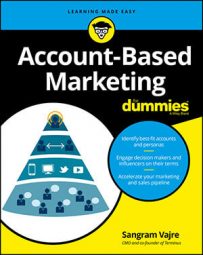The traditional B2B marketing and sales funnel tracks the various stages of a revenue opportunity as it moves through the sales process. The pipeline itself is named from the funnel. A lead became an opportunity as it progressed through the funnel, or pipeline, where it eventually became a closed deal.
Marketing and sales teams are familiar with the CEO or President examining all of the opportunities in the sales pipeline. This is why marketing has been focused on pouring leads into the top of the funnel.
New leads were acquired through purchasing lists, advertising, sending emails with content, and a variety of marketing efforts. When more leads came in, more potential deals entered the pipeline.
This figure illustrates the traditional B2B sales funnel.
From beginning to end, your prospect moves through a few predictable stages in this funnel. These are the stages of the traditional B2B buyer's journey:
- Awareness: A potential new customer hears about your company's product or service. This potential client is called a prospect, or lead. Leads are the most common metric that B2B marketers use to measure the success of their marketing activities and programs. In the Awareness stage, marketers pour leads into the top of the funnel to identify any and all prospects who want to learn about your product or service.
- Interest: A lead becomes a marketing qualified lead (MQL). The marketing team examines the lead's title, company information, and other attributes to determine whether this prospect should be forwarded to sales. If the lead becomes an MQL, then it's time to start engaging the prospect at a deeper level. The lead is passed on to sales, becoming a sales accepted lead (SAL). Now, the salesperson engages in a series of calls and emails to engage the SAL in an in-depth conversation or discovery call. In the discovery call, the salesperson learns more about the issues or pain points the SAL is experiencing. During the call, if your salesperson and SAL agree that there is a potential opportunity to do business, the SAL becomes a sales qualified lead (SQL).
- Consideration: The time when your SQL becomes an opportunity. Often, this stage is the breaking point for a lead. Your SQL is getting more people from his or her company involved. In B2B purchases, the decision rarely is left to a single decision maker. Your original lead, or champion, probably must persuade his or her internal stakeholders that they should purchase your product or service. This is when you negotiate with your potential new customer. At the Consideration stage, the marketing and sales teams must work in alignment to provide content that can overcome objections. The more handholding your team does during this stage of the traditional funnel, the more likely that a deal closes. Advancing a deal through Consideration always is an uphill battle for B2B sales.
- Purchase: The final stage of the traditional B2B marketing and sales funnel ends with a decision. Your prospect has progressed from an MQL, SAL, or SQL to opportunity. Now, the opportunity either chooses your company, chooses another competitor's products or services, or abandons the purchase. Your business either has won the deal, or wasted a lot of time and energy on the sales process.


